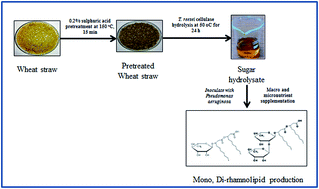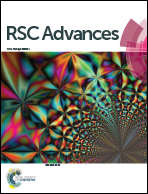Microbial rhamnolipid production in wheat straw hydrolysate supplemented with basic salts
Abstract
Rhamnolipids are important glycolipids that find application in the areas of crude oil bioremediation, enhanced oil recovery, food and pharmaceutical applications. The economic feasibility of rhamnolipid production mainly depends upon the cost of the substrate. Lignocellulosic biomass is a potential substrate for the production of several microbial metabolites and can also be used for rhamnolipid production. For the utilization of sugars from lignocellulosic biomass, the polymeric carbohydrates need to be hydrolysed for releasing the fermentable sugars for rhamnolipid production. In this study, pretreatment of wheat straw was carried out using sulphuric acid, phosphoric acid and ammonia. All the pretreated substrates were subjected to enzymatic hydrolysis using cellulases, produced by Trichoderma reesei NCIM 1186. Maximum reducing sugar yield (509.33 mg g−1 dry pretreated substrate) was obtained in the case of biomass treated with 0.2% sulphuric acid at 150 °C for 15 min which was further used for rhamnolipid production by Pseudomonas aeruginosa NCIM 2036. The highest rhamnolipid production of 9.38 g L−1 was obtained in sugar hydrolysate (mainly containing cellobiose) supplemented with MgSO4, Na2HPO4, FeSO4 and NaNO3. The production of rhamnolipid by P. aeruginosa NCIM 2036 using pure cellobiose as the sole carbon source was demonstrated. The current study showed that lignocellulosic biomass can be used as an alternative cost-effective substrate for rhamnolipid production.


 Please wait while we load your content...
Please wait while we load your content...